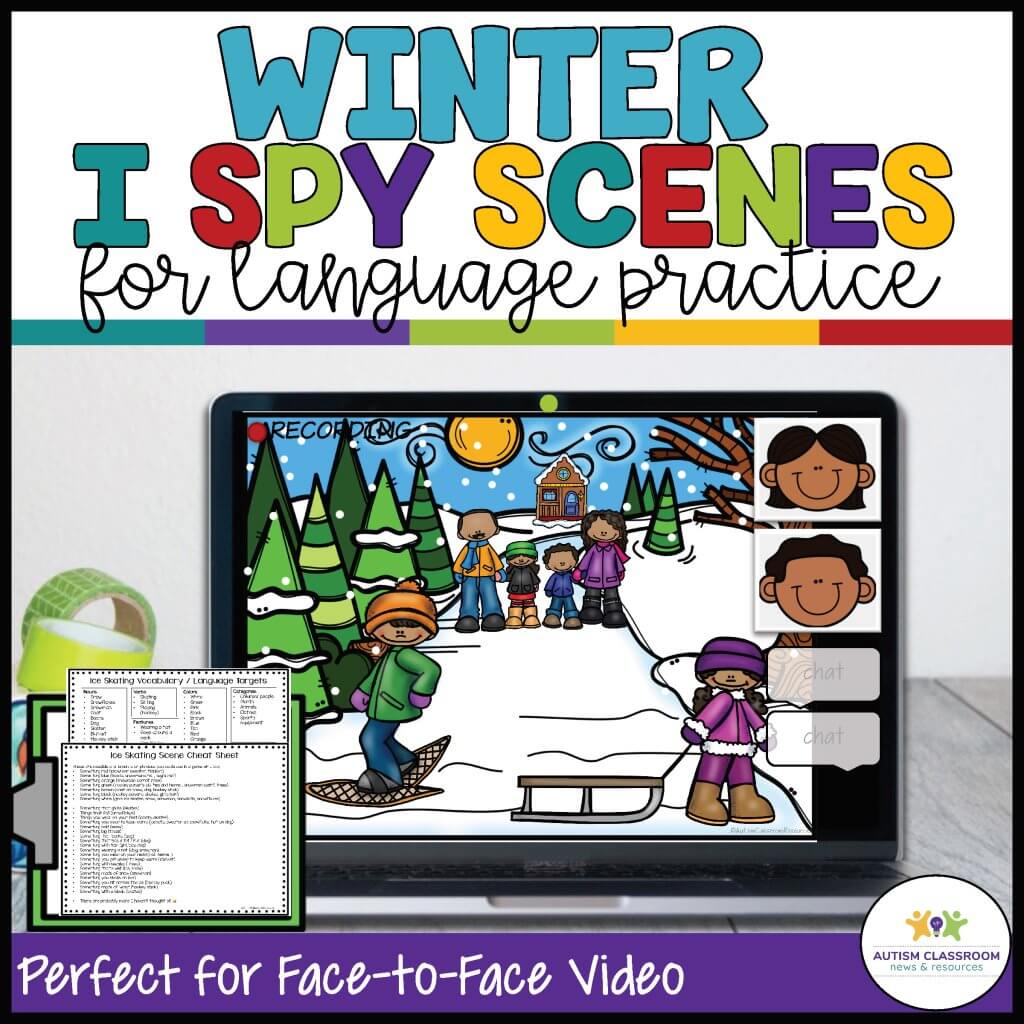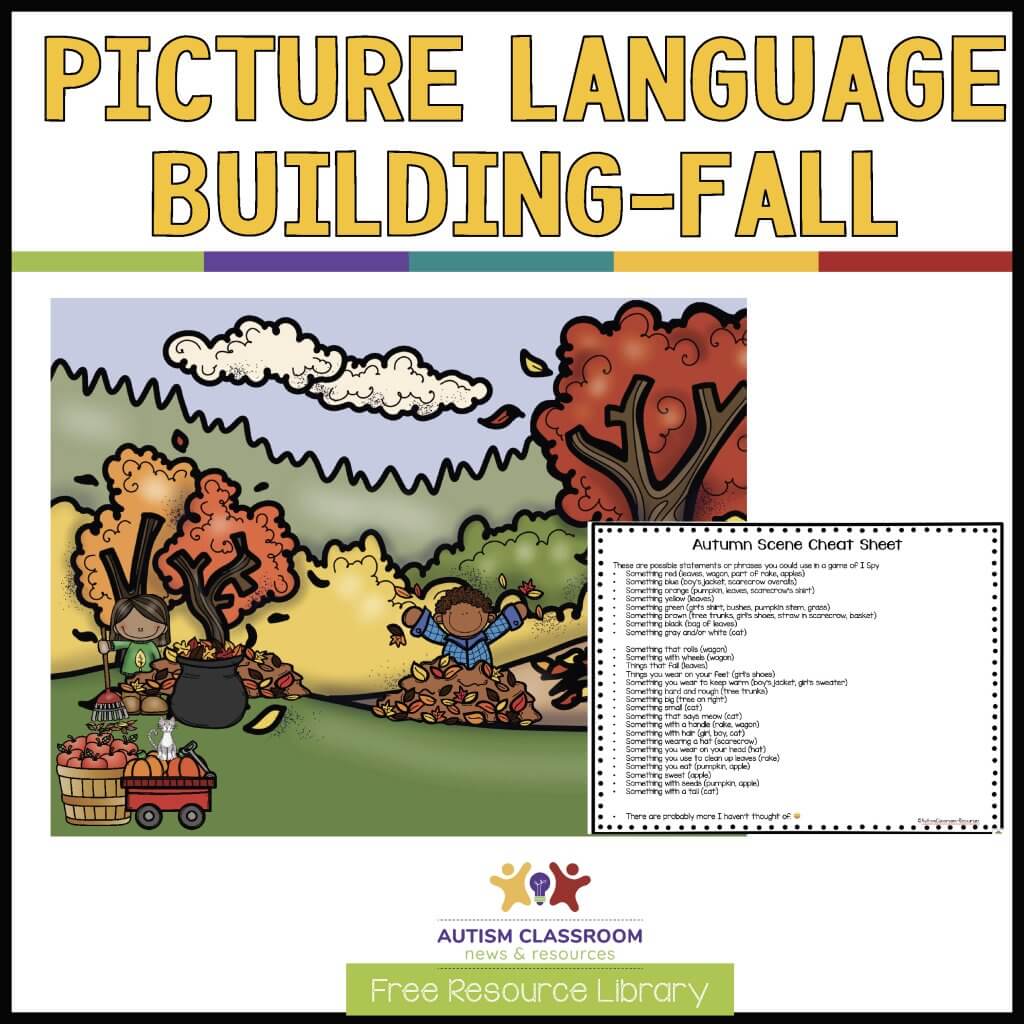I Spy games have always been one of my go-to strategies to fill in time and engage students to build vocabulary and facilitate language skills. I pull it out while we are waiting for the previous specials class to finish up. Or when we have some extra time at the end of a center before rotating that I was expecting. Over the years I’ve used them with all different types of students and for building all types of skills. But I particularly like them for building expressive and receptive vocabulary skills.
Most of you are probably familiar with the traditional I Spy games. I spy, with my little eye, something [fill in the characteristic]. The game lends itself to lots of ways to use it for building language skills. And it’s particularly good for different types of vocabulary. The key to using I Spy games is that you can modify it in different ways to adapt it for different skills and different learners.
Another things I came to realize about I Spy that makes it ideal for this year is that it’s great for distance learning. It’s equally as great for classroom learning, whole group instruction or 1-1 instruction. In other words, you can use it in tons of ways.
I Spy Scenes
So, when I was thinking about how to use I Spy in distance learning, I developed scenes to share with students on a screen. That way you know that everyone is looking at the same items. And you could control or include what vocabulary was targeted. I created them with a combination of different vocabulary including nouns, verbs, features, categories, functions, colors and more. And to make it easier I included cheat sheets for questions you could ask and vocabulary included.
I have two sets already available in my store and you can grab them below if you want something already done for you. And I have a free one in the resource library linked below you can download.
But you can also use other pictures to practice the vocabulary you are targeting. Or you could use the actual real world.
In addition to the cheat sheets, a great side benefit of the sets in my store is you could also use them for
- narratives describing the pictures,
- having students write or tell a story about the pictures,
- asking simple inference questions about the picture (e.g., Why does the boy have a shovel?)
- picture prompts for daily journal entries
- or just having students simply describe what they see for items and actions (e.g., What is the boy doing?)
Get a free fall scene to try I Spy with your students. It comes complete with vocabulary cheat sheet and questions.
Regardless of whether you are using prepared I Spy scenes or magazine pictures, photos or the real world, you can adapt I Spy in different ways to target different skills. In this episode I cover 6 different adaptations of I Spy that will help you:
- target receptive vocabulary
- target expressive vocabulary
- work on question asking and answering
- address vocabulary with feature, function and categories
- simplify I Spy for early learners
- work on turn taking
- and even target basic letter skills.
5 Ways to Play I Spy
I’m sure there are probably more ways to play I Spy than I will talk about here. But these are the ways I have used to help student build vocabulary and facilitate language development most effectively. If you have followed me for a while, you know I rarely play games the way they are intended. So I’ve included the classic I Spy games here as well as my variations.
#1 Traditional I Spy
I Spy makes a great ice breaker for starting off a group activity or just to fill in time to rpevent students from engaging in challenging behavior while waiting. In case you aren’t familiar with I Spy, the classic version is when you are looking at the environment or a picture and each person takes a turn saying, “I spy something [characteristic].” Then the other players have to guess what the person is referring to. So I might say, “I spy something green” and you might guess “Frog.” If you are right, it’s your turn. Sometimes, you add the classic, “I spy, with my little eye, something green.”
This version is great for working on turn taking and for students who are verbal and able to infer characteristics of items and use them to give you clues.
It won’t work as well for students who are nonverbal (obviously) or students who aren’t expressively using characteristics of items yet. Although they would be able to answer questions by pointing, they wouldn’t be able to take a turn asking the questions.
#2 Simple I Spy
In Simple I Spy, you and the student (or students) take turns naming or finding items in the picture. So, you might say, “I spy, with my little eye, a snowman” rather than describing it. And the student might point to the item you named. Then the student could take a turn doing the same.
This version works well for students who are still working on basic labeling or receptive identification of items. If students are working on basic labels, they answer the teacher. If they are only working on receptive ID, they can point.
#3 I Spy FFC
I Spy FFC focuses on identifying and finding things by feature, function, or class/category. So it’s like the traditional version but it focuses on specific types of characteristics. Working on FFCs is important because students need to learn to focus on more than just labeling items. If I describe something to a student, I want them to be able to find it, even if I don’t know its name.
I spy by color would fit under this as a characteristic. But so would size, shape, category, and how we use it. For example, “I see something we sit in.” And the answer might be a chair.
If you are having the student identify items you are working on receptive vocabulary by feature, function, class (RFFC). If they are describing the items for you to find, then it’s expressive (EFFC).
#4 I Spy Verbs
Yep, you guessed it, you can also play I Spy by finding and describing things by what someone is doing. So the Spy would say, “I spy someone that is throwing” and the responder might identify the boy throwing snowballs. Verbs represent another dimension of language building for our students. And I Spy gives them a fun way to practice identifying what people are doing. You could even have them act out the verb and build in some motor activity.
#5 I Spy Letters
OK, I’m stretching a little to build this into language facilitation, but it’s still a good skill to practice. In this version, you are identifying items by it’s beginning or ending letter. So you might say, “I spy something that begins with T” and the answer would be Tree. Or it might be “I spy something that ends with g” and the answer would be dog.
Mix and Match Versions to Build Vocabulary Individually
The best part about I Spy (besides its great ability to be pulled out as a fill-in activity) is that you can easily mix and match the way its played for easy differentiation. So you may give clues with I Spy Letters and the student may give cues with I Spy Colors. Or you may answer the student’s cues expressively, but he might point to the picture to answer yours.
You can also modify the whole game, as I noted earlier, and you give the cues and the student finds the item on the scene. Or you could point to the items and the student could tell you what he or she spies by describing it.
In addition to building vocabulary and language facilitation, you can also work on turn taking, listening skills, following directions, attention to detail, and other skills. And I Spy makes a great way to start off a distance learning session that is fun and engaging to help students want to turn on their mikes.











